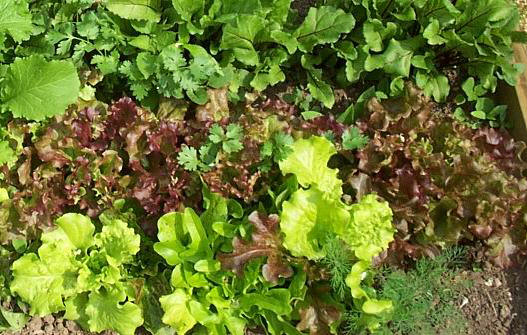Betty Jakum
Adams County Master Gardener
 Have you noticed that vegetable gardens are becoming more colorful these days? For the last couple of years, every new growing season greenhouses and garden centers offer more color varieties of standard vegetables like beans, peas, corn, tomatoes, cabbage, broccoli, beets
and carrots. My garden last year contained a number of new vegetable varieties in unconventional colors that, in the jargon of today’s redecorating trade, made my garden ’pop’: purple cabbage, yellow-striped tomatoes, pink-stalked Swiss chard and rows of early spring loose lettuce in shades of maroon, chartreuse and bronze. I also grew yellow-fleshed watermelons and white
and grayish-green pumpkins. Vegetable gardens are no longer the dull, utilitarian patches whose main function is providing food for the family table, but places that provide a treat for the eye as well.
Have you noticed that vegetable gardens are becoming more colorful these days? For the last couple of years, every new growing season greenhouses and garden centers offer more color varieties of standard vegetables like beans, peas, corn, tomatoes, cabbage, broccoli, beets
and carrots. My garden last year contained a number of new vegetable varieties in unconventional colors that, in the jargon of today’s redecorating trade, made my garden ’pop’: purple cabbage, yellow-striped tomatoes, pink-stalked Swiss chard and rows of early spring loose lettuce in shades of maroon, chartreuse and bronze. I also grew yellow-fleshed watermelons and white
and grayish-green pumpkins. Vegetable gardens are no longer the dull, utilitarian patches whose main function is providing food for the family table, but places that provide a treat for the eye as well.
Lettuces, especially the loose-leaf varieties, are some of the easiest vegetables to grow, and today we find them available in more colorful varieties than ever before. For sure, standard varieties of green lettuces are still available, but now there are red, burgundy, lime-green and bronze varieties with names like Red Velvet, Red Rapids, Rubin,
Sunset, Flame, Mascara, Pablo, Gold Rush, and Bronze Arrowhead. To highlight a few, Red Rapids sports red-tipped leaves with lime-green interiors and Rubin, Sunset and Mascara all provide the dark rich red color and textured leaf surfaces that make salads look so appetizing. Most seed companies also offer packets that mix together seeds of different-colored lettuces with
names like Summer Glory Blend, Sweet Salad Mix, Salad Fresh Cutting Mix, and Mesclun. I plant a row or two of a mix every spring, and the lettuces are as pretty in the garden as they are on the plate. Just a quick swipe of a kitchen knife, and I have a colorful and healthful lunch salad in minutes.

Rivaling lettuce for color are the different-colored tomatoes on the market today. So you think all tomatoes are bright orange-red? Well, let me introduce you to some lovely yellow varieties known as Sweet Tangerine, Yellow Pear, and Roman Candle. Then there’s Big Rainbow with its large bright yellow fruit streaked with scarlet. I grew this variety
last year, and it was almost too pretty to eat. Tomatoes can be green, too, and not just when they are underripe. Green Zebra comes in shades of yellow and yellowish-green stripes. Green Sausage produces elongated 4-inch green fruit with yellow stripes. There are tomatoes that are purple-black in color with telling names like Black Grim, Cherokee Purple and Purple
Russian. There is even a tomato variety known as Wapsipinicon Peach which produces 2-inch peach-shaped fuzzy yellow fruit. It’s an heirloom variety which means it is an open-pollinated cultivar commonly grown during earlier times. Many of the varieties I have cited in this article can be found in heirloom seed catalogs, so it’s possible that a much wider variety of color
was available in the gardens of earlier times, and we are just now reintroducing that variety into our gardens today.
Practically all commonly-grown vegetables are sporting new colors these days. Peppers are not just green anymore but orange yellow, purple, chocolate and black. Green beans now can be yellow, purple, and speckled, and when dried the bean color combinations are fascinating and too numerous to mention here. Traditionally purple, eggplant now comes in
a range of shades, including bright magenta, cream, green and white-striped with rose and violet. You can find a red corn called Bloody Butcher as well as blue, black, and multicolored varieties. Most members of the Cole family (cabbage, broccoli, cauliflower, Brussels sprouts, kale) now come in purple in addition to the ordinary green. White potatoes now share garden
space with their blue, red, yellow, and purple relatives.
It’s a veritable riot of color out there these days, making gardening more exciting and food choices more appetizing. St. Ignatius Loyola once observed: "It is not enough to cultivate vegetables with care. You have the duty to arrange them according to their colors . . . so they appear like a well-laid table." Choosing different colors for the
vegetables we usually eat will make this duty a lot more satisfying and fun.
Read other articles on growing herbs or vegetables